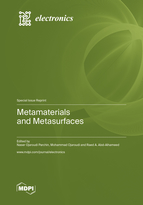Metamaterials and Metasurfaces
A special issue of Electronics (ISSN 2079-9292). This special issue belongs to the section "Microwave and Wireless Communications".
Deadline for manuscript submissions: closed (31 December 2022) | Viewed by 20079
Special Issue Editors
Interests: MIMO/diversity antennas; 5G/6G antennas; MM-wave phased arrays; multi-band/UWB antennas; RFID antennas; metamaterials and metasurfaces; Fabry resonators; fractal antennas; band-pass/band-stop microwave filters; reconfigurable structures; power amplifiers; electromagnetic wave propagation
Special Issues, Collections and Topics in MDPI journals
Interests: multi-band/UWB antennas; MIMO antennas; phased arrays; metamaterials; intelligent metasurfaces; smart-sensing; microwave cancer detection; computational brain-imaging
Interests: energy-efficient front-end design; radio frequency; energy harvesting; communications systems; 5G communications; sensor design; localisation-based services; signal processing; optimisation process; MIMO system design; health hazards; propagations, antennas and electromagnetic computational techniques
Special Issues, Collections and Topics in MDPI journals
Special Issue Information
Dear Colleagues,
Metamaterials and metasurfaces have recently attracted progressively increasing attention due to their anomalous and largely flexible properties. Their performance mainly depends on their subwavelength separation and geometric parameters. Metamaterials comprise a class of artificial materials whose physical properties can be engineered to exhibit various desired characteristics. Metasurface is a 2D metamaterial whose thickness is well below the wavelength of the impinging lights. Metamaterials and metasurfaces have unique interface transmission and reflection properties resulting from surface impedance, which can provide multiple advanced functionalities such as light focusing, hologram generation, polarization control, etc. Their extremely small hardware footprint enables their cost-effective embedding in various components of the environment. In recent years, they have emerged as a powerful technology with a broad range of applications, However, there are many challenges yet to be addressed in order for them to fulfil their potential in practical applications.
This Special Issue covers all aspects of metamaterials and metasurfaces. It also aims to highlight the exciting developments, ongoing trends, and latest achievements in their design and construction.
Submissions can focus on conceptual and applied research in topics including, but not limited to:
- Multi-functional metamaterials and metasurfaces;
- Metamaterial and metasurface antenna for massive MIMO;
- Metamaterial and metasurface antenna array decoupling;
- Polarization control with metamaterials and metasurfaces;
- Physics of metamaterials and metasurfaces;
- Intelligent reconfigurable metamaterials and metasurfaces;
- Metamaterial-based adaptative beamforming;
- Frequency selective surface (FSS)-inspired antennas;
- Fractal metamaterial absorber;
- Metasurface-based devices and applications;
- Metamaterial superstrate and substrate;
- Dynamic metasurface antennas for 5G/6G;
- Tunable metamaterial-based microwave filters;
- Focusing, imaging, and sensing techniques;
- Prototyping and experimentation of metamaterials and metasurfaces.
Submissions should be of a high quality for an international journal and should not have been submitted or published elsewhere. However, extended versions of conference papers that show significant improvement (minimum of over 50%) can be considered for review in this Special Issue. In addition, we welcome review papers that cover the subjects of this Special Issue.
Dr. Naser Ojaroudi Parchin
Dr. Mohammad Ojaroudi
Prof. Dr. Raed A. Abd-Alhameed
Guest Editors
Manuscript Submission Information
Manuscripts should be submitted online at www.mdpi.com by registering and logging in to this website. Once you are registered, click here to go to the submission form. Manuscripts can be submitted until the deadline. All submissions that pass pre-check are peer-reviewed. Accepted papers will be published continuously in the journal (as soon as accepted) and will be listed together on the special issue website. Research articles, review articles as well as short communications are invited. For planned papers, a title and short abstract (about 100 words) can be sent to the Editorial Office for announcement on this website.
Submitted manuscripts should not have been published previously, nor be under consideration for publication elsewhere (except conference proceedings papers). All manuscripts are thoroughly refereed through a single-blind peer-review process. A guide for authors and other relevant information for submission of manuscripts is available on the Instructions for Authors page. Electronics is an international peer-reviewed open access semimonthly journal published by MDPI.
Please visit the Instructions for Authors page before submitting a manuscript. The Article Processing Charge (APC) for publication in this open access journal is 2400 CHF (Swiss Francs). Submitted papers should be well formatted and use good English. Authors may use MDPI's English editing service prior to publication or during author revisions.








